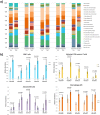Effect of CCL5 expression in the recruitment of immune cells in triple negative breast cancer
- PMID: 29559701
- PMCID: PMC5861063
- DOI: 10.1038/s41598-018-23099-7
Effect of CCL5 expression in the recruitment of immune cells in triple negative breast cancer
Abstract
Triple negative breast cancer (TNBC) is the most aggressive form of breast cancer with limited options of targeted therapy. Recent findings suggest that the clinical course of TNBC may be modified by the presence of tumor-infiltrating lymphocytes (TILs) and chemokine's expression, such as CCL5. Diverse studies have shown that CCL5 suppresses anti-tumor immunity and it has been related to poor outcome in different types of cancer while in other studies, this gene has been related with a better outcome. We sought to determine the association of CCL5 with the recruitment of TILs and other immune cells. With this aim we evaluated a retrospective cohort of 72 TNBC patients as well as publicly available datasets. TILs were correlated with residual tumor size after neoadjuvant chemotherapy (NAC) and CCL5 expression. In univariate analysis, TILs and CCL5 were both associated to the distant recurrence free survival; however, in a multivariate analysis, TILs was the only significant marker (HR = 0.336; 95%IC: 0.150-0.753; P = 0.008). CIBERSORT analysis suggested that a high CCL5 expression was associated with recruitment of CD8 T cells, CD4 activated T cells, NK activated cells and macrophages M1. The CD8A gene (encoding for CD8) was associated with an improved outcome in several public breast cancer datasets.
Conflict of interest statement
The authors declare no competing interests.
Figures






Similar articles
-
Significance of Tumor-Infiltrating Lymphocytes and the Expression of Topoisomerase IIα in the Prediction of the Clinical Outcome of Patients with Triple-Negative Breast Cancer after Taxane-Anthracycline-Based Neoadjuvant Chemotherapy.Chemotherapy. 2017;62(4):246-255. doi: 10.1159/000470900. Epub 2017 May 5. Chemotherapy. 2017. PMID: 28472798
-
The CD4/CD8 ratio of tumor-infiltrating lymphocytes at the tumor-host interface has prognostic value in triple-negative breast cancer.Hum Pathol. 2017 Nov;69:110-117. doi: 10.1016/j.humpath.2017.09.012. Epub 2017 Oct 6. Hum Pathol. 2017. PMID: 28993275
-
Residual cancer burden index and tumor-infiltrating lymphocyte subtypes in triple-negative breast cancer after neoadjuvant chemotherapy.Breast Cancer Res Treat. 2020 Jan;179(1):11-23. doi: 10.1007/s10549-019-05437-z. Epub 2019 Sep 16. Breast Cancer Res Treat. 2020. PMID: 31529299
-
The prognostic value of tumor-infiltrating lymphocytes in triple-negative breast cancer: a meta-analysis.Breast Cancer Res Treat. 2014 Dec;148(3):467-76. doi: 10.1007/s10549-014-3185-2. Epub 2014 Nov 1. Breast Cancer Res Treat. 2014. PMID: 25361613 Review.
-
Role of inflammatory infiltrates in triple negative breast cancer.J Clin Pathol. 2015 Jul;68(7):506-10. doi: 10.1136/jclinpath-2015-202944. Epub 2015 Mar 6. J Clin Pathol. 2015. PMID: 25750267 Review.
Cited by
-
Charting a killer course to the solid tumor: strategies to recruit and activate NK cells in the tumor microenvironment.Front Immunol. 2023 Nov 8;14:1286750. doi: 10.3389/fimmu.2023.1286750. eCollection 2023. Front Immunol. 2023. PMID: 38022679 Free PMC article. Review.
-
PARP Inhibitor Efficacy Depends on CD8+ T-cell Recruitment via Intratumoral STING Pathway Activation in BRCA-Deficient Models of Triple-Negative Breast Cancer.Cancer Discov. 2019 Jun;9(6):722-737. doi: 10.1158/2159-8290.CD-18-1218. Epub 2019 Apr 23. Cancer Discov. 2019. PMID: 31015319 Free PMC article.
-
A novel model associated with tumor microenvironment on predicting prognosis and immunotherapy in triple negative breast cancer.Clin Exp Med. 2023 Nov;23(7):3867-3881. doi: 10.1007/s10238-023-01090-5. Epub 2023 May 23. Clin Exp Med. 2023. PMID: 37219794 Free PMC article.
-
Ovo Like Zinc Finger 2 (OVOL2) Suppresses Breast Cancer Stem Cell Traits and Correlates with Immune Cells Infiltration.Breast Cancer (Dove Med Press). 2022 Aug 15;14:211-227. doi: 10.2147/BCTT.S363114. eCollection 2022. Breast Cancer (Dove Med Press). 2022. PMID: 35996562 Free PMC article.
-
Sequential modulation of the Wnt/β-catenin signaling pathway enhances tumor-intrinsic MHC I expression and tumor clearance.Gynecol Oncol. 2022 Jan;164(1):170-180. doi: 10.1016/j.ygyno.2021.09.026. Epub 2021 Nov 26. Gynecol Oncol. 2022. PMID: 34844776 Free PMC article.
References
-
- Balko JM, et al. Molecular Profiling of the Residual Disease of Triple-Negative Breast Cancers after Neoadjuvant Chemotherapy Identifies Actionable Therapeutic Targets. Cancer Discov. 2014;4:232–245. doi: 10.1158/2159-8290.CD-13-0286. - DOI - PMC - PubMed
Publication types
MeSH terms
Substances
LinkOut - more resources
Full Text Sources
Other Literature Sources
Research Materials

